Icy Inverts Cruise 2013 - Shipboard Blog - Dec 29th to Jan 1st
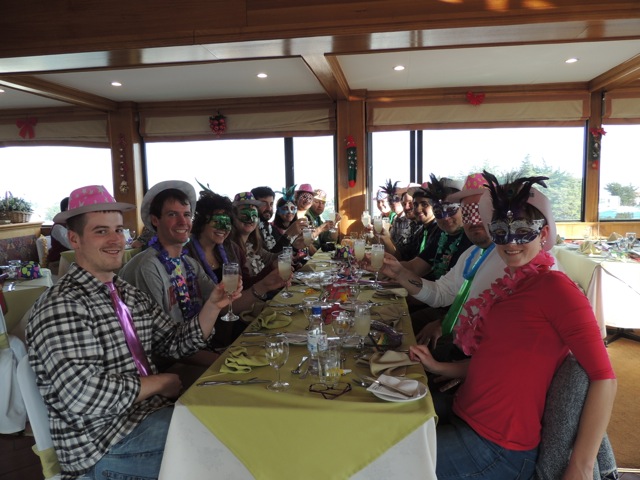
01 Jan 2013: Straits of Magellan (53° 55.3’S, 71° 16.9’W)
A new year and a new adventure: Our last night in Punta Arenas, Chile and what better way to spend it than with one last hurrah before we set sail. The Icy Inverts crew rang in 2013 with a top-floor celebration at the Hotel Finnis Terrae. The night was filled with delicious food, spirits, silly masks and hats (above picture), as well as great company. What a fantastic way to spend my first New Year’s outside the United States. I am truly looking forward to getting to know all the participants on this cruise better.
After a night of celebrating, morning came too quick for some of us. This was the first night sleeping aboard the R/V Palmer. For me, new sounds, new surroundings, and the fact that when you sit up in bed on the bottom bunk you are going to hit your head, is going to take some getting use to. At 0800 (8AM) we all had to check in with the Marine Projects Coordinator (MPC), to ensure everyone was in fact on the boat. After successfully being reported as being on the ship, some returned to their berths (rooms) for a siesta (nap), while other’s explored the outside decks of the ship.
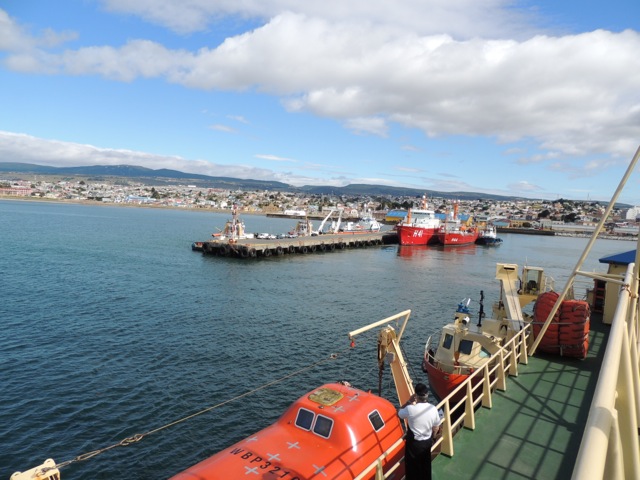
We began our journey to Antarctica at approximately 1000 (10AM). The fact that we are going to be conducting research on a boat for the next six week finally hit me as I watched the boat move away from the dock (above picture). There is no turning back now (not that I want to). The scenery is absolutely amazing. There is so much to see and so much I want to take in. Glad that today is one day that we basically have all day to do just that. Only a couple meetings were scheduled, including a ship safety training in which we had to practice putting on our survival suits (below picture) as well as get into one of the life rafts.
For me, the adventure ahead is finally setting in. I am extremely excited about the six weeks ahead and feel very fortunate for this opportunity!
For those who are interesting in tracking the current location of the ship please refer to the following link: http://sailwx.info/shiptrack/shipposition.phtml?call=WBP3210.
Contributed by: Dr. Pamela Brannock, Postdoctoral Fellow, Auburn University
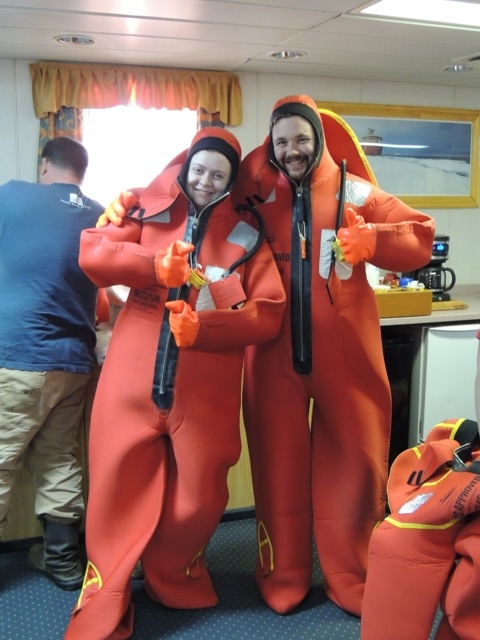
***************************************************************************************
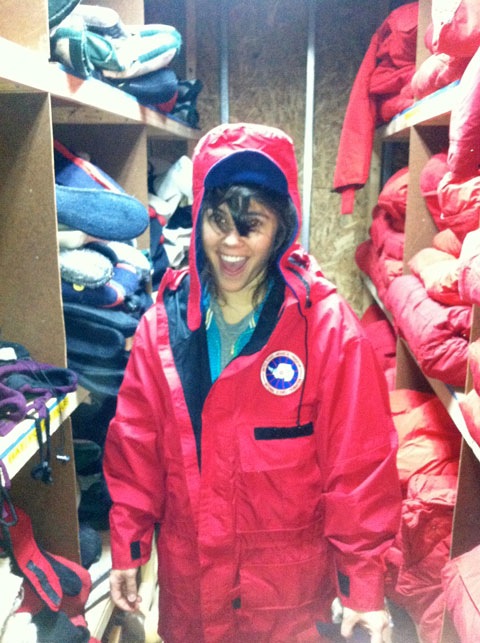
31 Dec 2012: South America (53o 10.2'S, 70o 54.4'W)
Participate don’t anticipate! Knowing that this would be the last morning I woke up on land immediately brought me to the open window of my quaint hotel room for a few minutes to take in the town of Punta Arenas. The sights of green vegetation speckled with bright houses with no particular color scheme and humans walking around freely without a parka on were something to be cherished.
With the ships departure in T-minus less than one day and the knowledge that we must be a self-contained island for over a month, really gave us incentive to be productive and execute as much last minute preparations in lab setup as possible. If we accomplish this, then we can enjoy the scenery of the Straights of Magellan and fade into our rooms (which are the most cozy) like ghosts once the rough seas have their way. One preparatory task led us to the Antarctic Science Contract warehouse to be outfitted with “Extreme Cold Weather” gear (above picture). This place was an outdoor enthusiasts paradise. Imagine aisles filled with shelves of fleeces, steel-toed boots, hats, and Carhartts, (broken in Carhartts might I add). For an hour we milled around trying on all our gear making sure we did not get stuck with two left-handed gloves and that everything fit appropriately.
Back in the lab, final details are being addressed with organizing inventory that was a little late coming in. With knowledge that we will be crossing the Drake Passage in the next few days, we made sure everything was secure and incapable of any mobility. Underneath the lab tables, there are boxes where materials like Nalgene bottles (to put collected organisms in), tubes, petri dishes etc. are stored. This arrangement cannot risk shifting objects, and with that being said, I learned something new today: a fishermen’s knot. Kevin, Joie and David got their daily dose of power tools by strapping down all the microscopes with bungee cords into the lab benches (below picture). Slowly, more details about life for the next 40 some days are trickling in, making this coming voyage more of a reality. For example, we all found out who we are bunking with and what teams and shifts we will be working in. Looks like I have the “morning shift” which is relative. For the first time in my life I just switched my watch over to military time. This sailor experience will not be partial.
My father always told me “there are two things you always respect in life, the mountains and ocean, because they can both destroy you.” Seems morbid, but it is actually a quite beautiful piece of wisdom that truly shows the mightiness of both. Growing up skiing has shown me half of this truth and I believe I am about to affirm the other bit.
Contributed by: Alex Medved, Undergraduate Senior, Auburn University
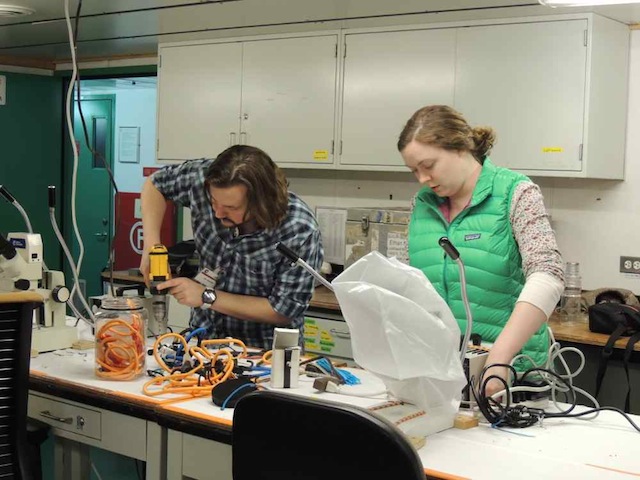
***************************************************************************************
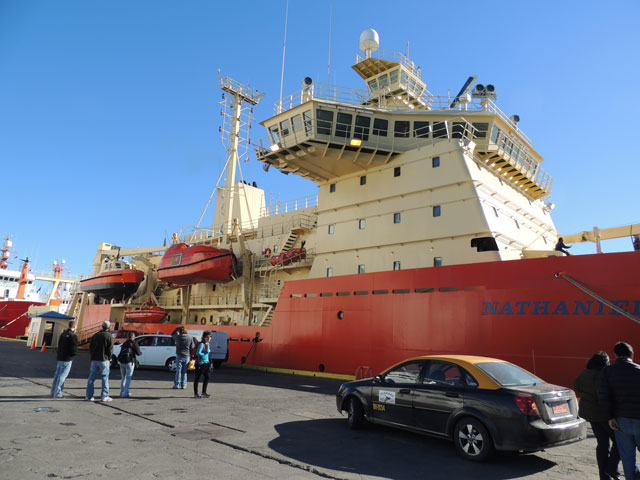
Our first day and night at port in Punta Arenas has been exciting so far, full of preparations for our upcoming journey to the ice. At our first full day at port, we all met at the docks outside the R.B. Palmer at 0900 (9AM normal time). The boat was much larger than I anticipated (above picture), although it was still about five times smaller than the massive Silver Cloud cruise ship squatting across from it. We all joked that we were going to try to drag race the cruiser to Antarctica, and that the Silver Cloud’s passengers would be on deck sipping mojitos and watching us scientists drag nets and invertebrates up from the deep. Personally, I think we have the better gig, since we get to touch sea spiders, sea stars, and all manner of other cool creepy crawlies.
After we got our official NSF Grantee badges and moved on board, we promptly got lost looking for our main lab, although we did stumble in awe across luxuries that many of us were not expecting: a small workout room, a sauna, a lounge with books and other entertainments, and super nifty bunk beds in our cabins. Foreshadowing of the nasty waves ahead was evident, as everything was bolted down—even the bookshelves have a metal bar running across them to prevent them from taking flight in rough seas.
Eventually we made it to the right place and were briefed on the rules and our agenda. Also, Kevin and Dave managed to make the most unpalatable pot of coffee known to man, and were mercilessly teased with the joke, “How many scientists does it take to brew a pot of coffee?” We still don’t know, although we’ve discovered that it only takes two to ruin one. :)
After a briefing, we began the task of taking inventory of the lab materials that we had on board, and seeing if they matched up with our master list of what was supposed to be there. This required unpacking and recording the quantity of each item (below picture), and was complicated by the fact that there are technically three different science groups aboard this vessel. Thus, in addition to figuring out which materials had already been counted, we had to figure out which nondescript brown box was ours, and which nondescript boxes belonged to someone else. There were discrepancies between our list and the master list. At some points, our frustrations were tangible, but through teamwork, patience, and trouble-shooting together, we eventually got the mess sorted. Soon, we will start organizing and placing items in their homes on the shelves, as well as setting up and tying down our more sensitive equipment.
I am loving this so far. The food in the mess at lunch was amazing (fresh salad, homemade spinach and chicken soup, salmon tortellini, and asparagus), and it feels good to be busy after 48 hours of travelling, sitting, and waiting. My fellow crewmates have also been great. I have never met a group of individuals who are more friendly, qualified, and eager to help out, and I am really looking forward to learning from them and getting to know them better.
Until next time.......
Contributed by: Abigail Hollingsworth, Undergraduate Senior, Central Michigan University
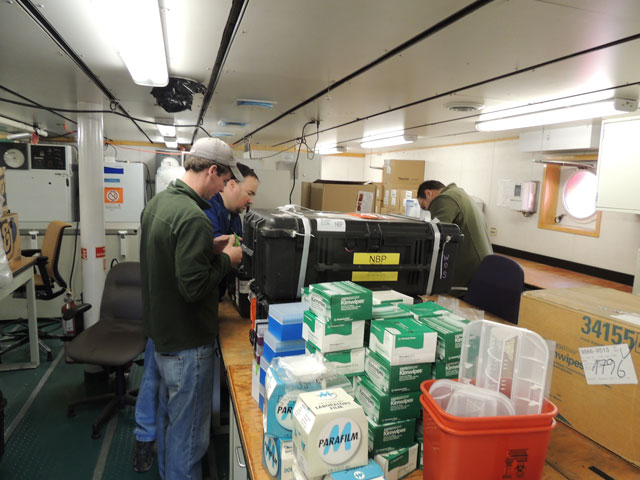
***************************************************************************************
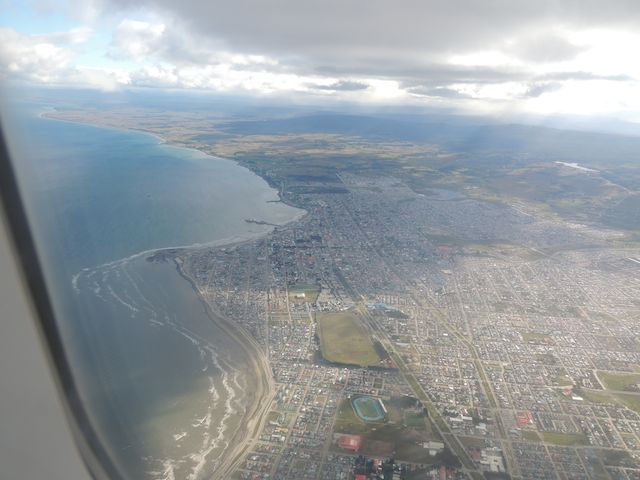
29 Dec 2012: South America (53o 10.2'S, 70o 54.4'W)
Today began the first leg of the lab's journey down to the Southern Ocean. The majority of us flew out of Atlanta, Georgia (USA) on a nine and a half hour flight to Santiago, Chile. It was a red-eye flight, but very few of us got any sleep (myself included). So we very much appreciated that the Antarctic Support Contract (ASC) guided us through the Santiago airport and directed us to their office where we could get some rest. Once in Santiago, we were joined by other researchers from Europe and other parts of the United States who will be partaking in the research expedition with us. The majority of the day was spent inside the Santiago airport until we departed on different connecting flights to Punta Arenas, Chile (above picture) late in the afternoon. While we were all just ready to be done with the journey, this portion of the flight offered spectacular views of the Andes mountain range. On the way from the airport to our hotels, we were able to spot the R/V Nathaniel B. Palmer, the research vessel that we will be spending the next six weeks on. After a long day and a half of travel, the Palmer was a very exciting sight, since we have finally reached our destination. While tonight we were just happy to get here and get a shower, the real work is about to begin, but I don't think there is any place that any of us would rather be.
Contributed by: Matt Galaska, Ph.D. Candidate, Auburn University
Last updated: 11/12/2013
